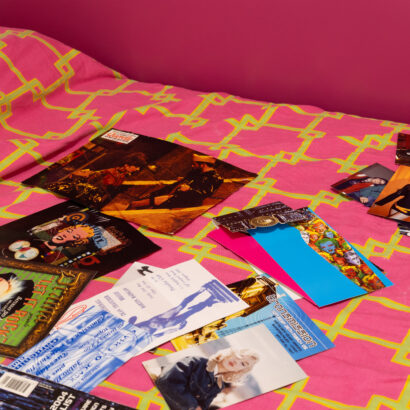Responding to a population boom, local authorities built high-rise blocks like Withy House from the 1950s to early 1970s in an effort to create ‘streets in the sky’. However, after decades of privatisation and a chronic lack of funding, many of these blocks had been demolished by the new millennium.
Nadia and Ashley have been looking for another LGBTQIA+ flatmate to move into their spare room. They recently met Alex at The George and Dragon in Hoxton, and later that same night, invited her to move in.
Their tenancy agreement forbids any changes to the flat without the landlord’s permission. However, after spending the last few evenings with Alex watching reruns of home makeover shows like Changing Rooms, they have all been inspired to grab a paintbrush and go for it.
More than just redecorating, they want to be able to personalise their home, and create a safe and serene space.
This room was curated with the help of participants from LGBTQIA+ communities and funded through Art Happens, Art Fund’s crowd-funding platform, John Shakeshaft and Andrew Hochhauser KC.
Objects to look out for

Club memorabilia
As homes away from home, bars and clubs have always been key places for members of the LGBTQI+ community to meet and socialise in safe environments. Free decoration or mementos of an amazing night, club flyers, listings and ephemera are dotted around the rooms as tokens of east London’s iconic queer nightlife.
Club memorabilia, Credit: Jaron James

Maggie as Disco Diva
By the 2000s former Prime Minister Margaret Thatcher had become a much-loathed figure among many communities, with the impact of homophobic laws passed by her government lingering on far past her tenure. This satirical collage from Muzik Magazine uses camp silliness to question and mock her legacy.
Maggie as Disco Diva, Credit: Jaron James

Stereo
“It was quite a big investment at the time and it was good to have a quality system to listen to my records on… It represents the ability to hear black music in our own homes at a time when there wasn’t much played in the mainstream.” – VM
Stereo, Credit: Jaron James

Free digital guide
Explore Museum of the Home with our digital guide on Bloomberg Connects, the free arts and culture app.
